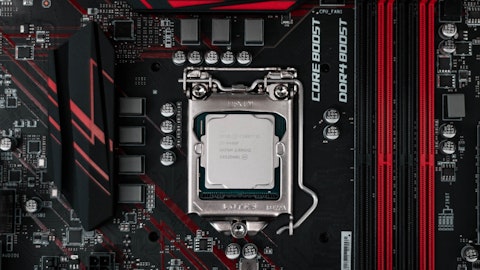Mike Slessor: Yes. Well, it didn’t take into account HBM, but there were also some other puts and takes as there are in any target model. We’ve had some headwinds associated with China. That’s one of the reasons why we divested the business. So, there’s some things that are positive. There’s some things that are negative and we’re still tracking as you can see from the second quarter guide and our comments on the call. We’re still committed to the $850 million model. As we did last time around, we want to put the numbers up on the board at least from a quarterly standpoint. A quarterly run rate of 212, a gross margin of 47%, EPS of $0.50 in a quarter, and before we publish a new model. Now, given our limited visibility, we’d certainly hope that happens sometime in the second half here, but we don’t have the visibility to commit to that.
The discussions around HBM, digestion and some of the other pieces, yes, I would like to be able to do it in the third quarter or the fourth quarter, but we just don’t have the visibility to be able to foreshadow that yet.
Christian Schwab: Okay. And then, could the digestion period be maybe a little bit later than given, I don’t know, Samsung just said that, they’re going to high bandwidth memory is going to be up threefold this year and then it’s going to double again the following year and we should have a third customer ramping with you shortly. Is that fair?
Mike Slessor: Yes. There’s no question that digestion could be later at a different time. It doesn’t need to be in sequential quarters, right? But again, based on the strength and the step-up in the second quarter, we want to make sure that we’re producing the products that have been ordered for us, delivering a quality product on time to these customers and supporting whatever ramp they’re then going to drive in the second half. But we just don’t have the visibility there to be able to make a definitive statement.
Christian Schwab: Great. No other questions. Thank you.
Mike Slessor: Thanks, Chris.
Operator: Thank you. One moment for our next question. Our next question comes from the line of Krish Sankar from TD Cowen. Your question, please.
Robert Mertens: Hi. This is Robert Mertens on for Krish. Thanks for taking my questions. The first one just jumping back to the high-bandwidth memory. It was roughly say $10 million or so during the December quarter and doubling this quarter, and then should also be up another $10 million or so. The June outlook, assuming maybe like a 20% to upwards of like 40%, sequential growth for the high bandwidth memory portion. Did I hear you correct for the second half of the year that you would expect memory to be up half over half or was that a comment to the overall business and sort of what are the major potential upsides to the second half of the year?
Mike Slessor: Yes. We certainly didn’t make any definitive comments about the second half of the year. My answer to Christian’s question a moment ago, given our lead times are well within a quarter, we just don’t have the visibility to make a statement on the second quarter. Now I do think for HBM, there’s some interesting dynamics at work, given the strong investment plans that the hyperscalers have that are going to drive data center spending, that are going to drive more HBM shipments. And as somebody noted on this call, our customers are all conveying strong growth for HBM through the second half of the year. So I think potentially, sure, we can see that. But I just don’t have the direct visibility right now, given the shorter lead times to really commit to that or make any statements that set expectations for the second half.
Robert Mertens: Got it. That’s helpful. And then, just quickly in terms of Intel and their ramping foundry business. I don’t know if you could provide any commentary in terms of if you’re starting to see any sort of business there or expectations as their foundry starts to ramp. Would you expect that to be a similar percent market share, as your current market share with Intel, or how that might shake out?
Mike Slessor: Yes. I think with any foundry customer, there’s a couple of different business models. Certainly, when the foundry has a contract to not just produce the wafers, but then test and assemble the wafers, we compete for that business at the foundry. Now sometimes the fabless customer manages their test and assembly and just buys the wafers from the foundry. In the scenario, in the first scenario, where the foundry is managing not just wafer production, but test, wafer sort, assembly, and final test, those are areas where we’d expect to have if you like, our natural share position irrespective of the foundry.
Robert Mertens: Okay. Got it. That’s helpful. Thanks.
Mike Slessor: Okay. Thanks, Rob.
Operator: Thank you. [Operator Instructions]. And our next question comes from the line of Tom Diffely from D. A. Davidson. Your question, please.
Tom Diffely: Yes. Good afternoon. Thank you. So, maybe a question for Shai on the margin structure on the model. When I look at the guidance for the out quarter and compare it to a couple of years ago, we were at the same revenue level, margins are a few 100 basis points lower, where the earnings quite a bit lower. Curious, what is the biggest difference between then and now? Is it just increasing capacity? Is it the mix of what you are selling today? Maybe just a little more color on that if you could.
A – Shai Shahar: Yeah, Tom. That’s a good observation. I mean, if we go back, as far as I recall, Q1 of 2022 with similar levels of revenue to the midpoint of the range, I think it was $197 million, gross margin was 49%. But the mix was very different. Two years ago, the Systems revenue was higher and the gross margin was higher. It was about 50%. Foundry & Logic was above $110 million and at the midpoint of the guidance, we are talking about $100 million of Foundry & Logic. DRAM was about $35 million two years ago, and now we’re talking about $55 million. You can see the difference in the mix. Now we are talking about lower Foundry & Logic versus two years ago, higher DRAM that negatively impacts the margin and that’s why, let’s call it, only 45% versus the 49% we saw two years ago. But it’s a great step up on our way to achieve our 47% gross margin at $850 million of revenue.


